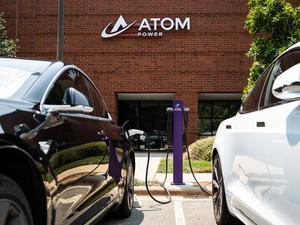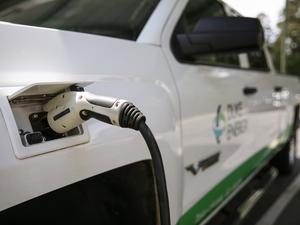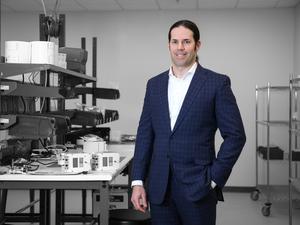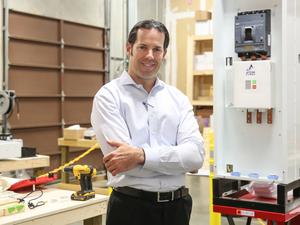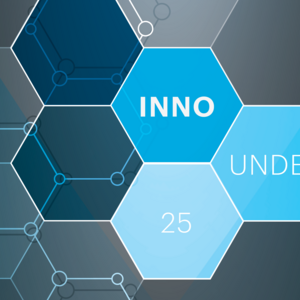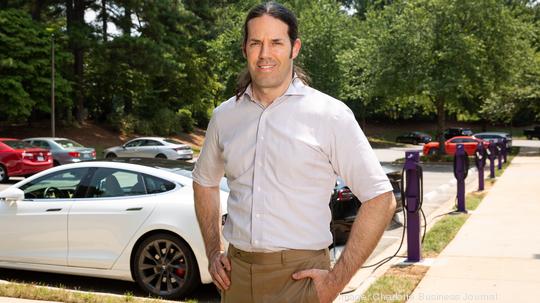
Looking to tap the burgeoning electric-vehicle charging market and planning to introduce its first residential product next year, Atom Power plans to open a 150,000-square-foot manufacturing facility in the Charlotte region next year.
CEO Ryan Kennedy says Atom Power estimates that will mean adding 50 workers — to the 30 now — by the end of 2022 and 500 more by 2025. And after more than a year of study, the company has decided against contract manufacturing and will bring all production in-house.
The plan is to do all the manufacturing in the region — both at the new facility and in a space in its recently acquired 23,000-square-foot headquarters in Huntersville.
The need for the increased capacity is built on two key changes in the company’s focus. One is the adaptation of its core digital circuit breaker product to a highly efficient, enormously flexible EV charging system designed to eliminate major infrastructure expenses needed to install fleet chargers for governments, commercial companies and even apartment buildings.
The second is the miniaturization of the Atom Switch circuit breaker so it fits in standard home electrical boxes. But Kennedy says the miniaturized version will enable significant peak-load cutting capacity for residential customers and allow for more effective demand response programs from utilities.
Kennedy sat down with the Charlotte Business Journal recently to talk about his company’s evolution since its founding in 2014. An edited transcript of that conversation follows.
What changed your initial focus on manufacturers, data centers and commercial buildings as your key markets?
It wasn’t really our focus. We got pulled into those unchecked. For a product like this — a hyper-smart circuit breaker that’s digital — you tend to get more industry pull from the higher tech folks. Those tend to be in the industrial space as well as data centers. It wasn’t a conscious choice.
How did that change?
There’s four major breaker companies in the world that have dominated the industry for over a century. And here comes another company that’s not only going to build another breaker but build a breaker that’s semiconductor-based — the holy grail for the electrical space since the 1980s. And we actually pulled it off and got the first, second and third UL listings on the products. We had to ask ourselves: Are we making a good approach to the markets? And the answer was: No, we’re not. Simultaneous to that we began getting pull from two major forces. All of a sudden you started seeing vehicle fleet electrification emerging as a major infrastructure build. EV charging has been on the radar since 2018, but it really didn’t start showing itself to be huge until last year when he started hearing all these different municipals going all electric; parcel pick-up and delivery going all electric; multifamily (projects) going all-electric. And suddenly you have to charge a lot of cars or trucks, with a lot of power at facilities that don’t have the power.
A huge piece of the fleet value proposition is to be able to charge in a way that manages to your energy flow. So how do you do that? Atom Power’s always had that energy management chunk in mind. We provide that. The other pull we got was for the residential breaker product.
What do you mean by “pull” from the EV industry?
We had some fairly major potential customers reach out to us. One that’s a utility. One is a property developer of multifamily projects, and one is an actual electric vehicle company. I wish I could name names, but we’re not in the clear yet. I would say those three major entities are what kick-started it all. This was June or July last year. As a utility or a city, I’ve got to provide EV infrastructure for charging. What’s the scalable thing that I could put across any customer’s portfolio and it looks the exact same and it’s going to stay the exact same for at least 10 years, if not 20 years? That’s our system. The charger is built for longevity. And the expensive electronics are not out in the parking lot the way it is with other systems. Outside all you have is a pedestal that is basically conduit, wire and a plug. Your electronics are protected inside. It’s a highly scalable product.
What’s in it for the EV makers?
EV companies are trying to offer the complete solution, especially the fleet EV companies. The barrier for to entry often isn’t the electric vehicles themselves. It’s the infrastructure that has to get with it. The infrastructure costs are a huge barrier to large-scale fleet adoption.
The national electrical code basically says you have to put in the infrastructure for your maximum charging output that’s in the national electrical code or you can have an automatic load management system. What that means is if I am a customer needing to put in EV infrastructure, especially a big one, and say all my EVs added up equals a megawatt I need a megawatt of power. That means a transformer from your utility, a switchgear, in the building, conduit wire, all this other stuff — unless I have an automatic load management system.
At Atom Power, we are the load management system because our breakers are the power system. Customers now don’t have to put the full megawatt infrastructure in. They can put a quarter of that in.
You mentioned the residential product. Are you going to produce EV chargers for the residential market, too?
There is not much value for us in a residential charger because it is such a commoditized market. But we are going to be releasing residential products next year — miniature breakers for the residential sector. The impact of that is one of the key loads that we would feed from these breakers is that residential EV charger. For us, the pain point we’re seeing is really from the utility side of that equation. At today’s standard charge levels, you put in a single charger you’re going to increase the electrical demand on your home by 27% to 40%.
Utilities want a way to curtail that load to where it makes sense to charge like 10 p.m., 11 p.m., midnight. But the habits are, when you come home in your car, you plug it in and leave it there for the rest of the night.
When you plug your car in at 5:30, that instantaneous load hits. Multiply that out across many, many homes, it’s big problem. And what a utility wants to do is flatten the curve.
They can’t put in place a program that addresses every charger manufacturer out there, but you do have a common breaker. Let’s make that smart. Let’s make it controllable so that we can offset the major capacity problem that’s created by a whole lot of chargers coming online at once.
Are these new circuit breaker boxes to install in homes, or just the individual breaker switches?
It’s not like commercial where we had to make our own box. Residential is a different story. You go to Lowe’s and Home Depot, most of the breakers you find on the shelf are interchangeable for most manufacturers’ boxes. So, our approach is to make a breaker that fits in those same boxes.
This is the value proposition for utilities. I got my standard panel. I replace the breakers for load that can be curtailed (EV chargers, hot water heaters, HVAC). Utilities view these three loads, as high-impact loads. They happen to pull most of the energy in the home — roughly 62% to 74% of the load. But the customer doesn’t necessarily notice if they are off for some period of time.
The problem is utilities today have this sort of extremely disaggregated approach on demand response to curtail those high-impact loads. They typically do just the HVAC. You can curtail that, but it’s only for about 30 minutes before people start noticing. Hot water, you can curtail for about an hour, but there is hot water in the tank. Cars you can charge later in the night. It gives utilities a high level of flexibility that they’ve never had.
When does this product come out?
This product will be out in August of next year. The good news is we’re realizing the manufacturing impact of solid state. What’s in that product is effectively the same stuff that’s in our bigger switches only smaller. So, the technology leap is not great. It’s more of an execution leap right now because you have to miniaturize it. It’s an iPhone problem. You have to pack a lot of things to a very small form.
We’ve built prototypes that are in operation. The key for this product is not the technology design. Most of our time — this is why it’s next August and not December of this year — is based on two things. One is from the software standpoint is cybersecurity. That’s a major concern for us and something that has to be absolutely bulletproof. The other piece is the manufacturability. The demand we’re seeing today is in the hundreds of thousands of units. So, every little design element has to speak to shaving time off manufacturing and enabling the automation of that manufacturing.
How do you market this new product?
We haven’t quite cracked the nut on addressing the consumer. So, we are focused more on utilities, co-ops and third-party energy aggregators that do the demand response programs for the utilities. We’re going to give them the tools to make demand response much more effective. It enables them to streamline the process. With the new circuit breaker, utilities or aggregators can say we have this program, and it’s a range of energy savings all controlled from the breaker. The rebate to the customer goes up the more they adopt.
